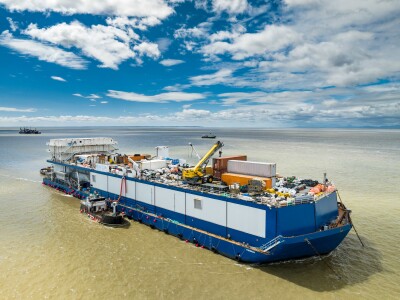Only you can prevent vessel fires
From U.S. Coast Guard reports.
More than 20 percent of fishing boats lost from 1992 to 2007 traced the cause to a fire, making fire the second leading cause for sinking. More than 70 percent of those fires started in the engine room or machinery spaces (which is, of course, a great place to find fuel and ignition sources).
Most fires can be prevented by checking for faulty wiring and other electrical hazards; ensuring fuel lines and connections are in good shape and not leaking, and hot surfaces are insulated properly; stowing combustible materials; and keeping spaces clean and free of debris. In other words, good housekeeping.
During a mid-February bottom-fishing trip, a 43-foot fiberglass boat was anchored off the coast of Charleston, S.C. During the night, the anchor dragged and the boat was hit by a rogue wave, which rocked the batteries out of its box and shorted out the electrical power.
Without a working backup, the skipper activated the EPIRB to get assistance from the Coast Guard. A rescue helicopter was unable to help the crew regain power, so they were lifted ashore, leaving the boat at anchor unattended. The next day, only a life raft was found in the area. It was suspected that the shorted-out electrical equipment started a fire and the vessel sank without an operating bilge pump.
A few days later, a 42-foot fiberglass trawler-longliner was steaming to a yard in the Hampton Roads, Va., area for bottom cleaning and painting. It had not been on the water for a few months and was up for sale.
Prior to the trip, the operator checked the engine and equipment. All seemed to be in order other than one of the alternators making a little noise. Some distance into the trip, the skipper noticed the amp meter was jumping erratically, then the autopilot suddenly turned to starboard.
When the skipper opened the engine room hatch to investigate, he saw flames near the battery box. Billows of black smoke erupted, so he discharged one fire extinguisher through the engine room hatch and one through a ventilation opening, but neither had any effect on the fire. The skipper was unable to reach the fuel shutoffs or the engine shutdown.
Quickly realizing the fire was out of control, he launched the life raft and entered it without the EPIRB or a PFD. He called his brother on a cell phone and was soon picked up. Fire and rescue boats attempted to put out the fire, but the boat was flooded and sank. It was suspected that the wiring around the alternators or the batteries started the fire.
Both vessels were total losses, but the crews knew when to abandon ship, so there were no injuries or fatalities.
Lessons learned
In the first incident, the batteries were jarred loose during heavy weather because they were not secured in their box. When the batteries shorted, they very likely caused some material in the area to begin smoldering, but the fire did not develop until after the vessel was abandoned.
In the second incident, it is believed the fire started around the battery box. The skipper may have missed an opportunity to discover a hazardous condition when he ignored the noisy alternator.
Making safety decisions in a timely manner gave both captains the opportunity to call for help before it was too late. In the first instance, the skipper activated the EPIRB; the second safely launched a life raft.
Conducting a safety and equipment inspection of your vessel before getting underway can be its own form of fire insurance. Also, when checking equipment and systems, inspect further and make repairs if something seems amiss or is making unusual noises. Make sure wiring and hot surfaces are properly insulated, fuel lines are intact, valves and cut-off/shut-down switches are accessible, and alarms and pumps are functioning properly. Check that everything is stowed properly in case of heavy weather.
The Coast Guard can assist with a Dockside Safety Examination to identify equipment deficiencies or problem areas you may have overlooked. Contact your local unit for more information, or to schedule a free, no-fault examination. Visit www.fishsafe.info.






